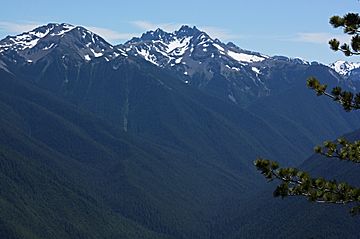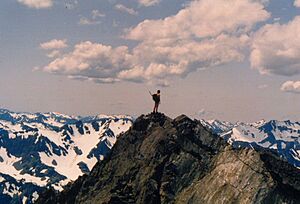Mount Walkinshaw facts for kids
Quick facts for kids Mount Walkinshaw |
|
|---|---|
| The Citadel | |

Mount Walkinshaw centered
(Gray Wolf Ridge's South Peak to left) |
|
| Highest point | |
| Elevation | 7,378 ft (2,249 m) |
| Prominence | 378 ft (115 m) |
| Parent peak | Mount Clark |
| Geography | |
| Location | Jefferson County, Washington, United States |
| Parent range | Olympic Mountains |
| Topo map | USGS Mount Deception |
| Geology | |
| Age of rock | Eocene |
| Type of rock | shale, pillow basalt |
| Climbing | |
| First ascent | 1961 by Joe Munson, Jim Parolini |
| Easiest route | Scramble class 3 via West Side or Gray Wolf Ridge |
Mount Walkinshaw is a mountain in the Olympic Mountains of Washington state. It stands about 7,378 feet (2,249 m) tall. This peak is located in Jefferson County.
Mount Walkinshaw is inside Olympic National Park. It is the most northern peak in a group called The Needles. Its closest taller neighbor is Mount Clark, which is about 0.9 mi (1.4 km) to the south. The Gray Wolf Ridge curves to the northeast. Mount Walkinshaw is in the eastern part of the Olympic Mountains. It is also in the area where water flows into the Dungeness River. This area gets less rain than other parts of the Olympic Mountains. This is because it is in the rain shadow of the range.
Mountain History
Mount Walkinshaw was first known as The Citadel. Its current name was officially chosen in 1965. It was named to honor Robert B. Walkinshaw (1884-1963). He was an author and a lawyer. He worked hard to protect nature. His efforts helped create Olympic National Park.
Robert's son, Walter Walkinshaw, suggested the mountain's name. He wanted it near Mount Clark. Mount Clark was named after Irving M. Clark. Irving Clark was also a nature protector from Seattle. He was an old friend of Robert Walkinshaw. The first people to climb Mount Walkinshaw were Joe Munson and Jim Parolini. They reached the top in 1961.
Mountain Climate
Mount Walkinshaw is in a marine west coast climate zone. This means it has mild, wet winters and cool, dry summers. Most weather fronts, which bring changes in weather, come from the Pacific Ocean. They move northeast towards the Olympic Mountains.
When these weather fronts hit the tall Olympic peaks, they are forced to rise. This causes them to drop their moisture as rain or snow. This process is called Orographic lift. Because of this, the Olympic Mountains get a lot of rain and snow. This is especially true in winter. During winter, it is often cloudy. But in summer, high pressure systems over the Pacific Ocean bring clear skies.
The snow in this area can be wet and heavy. This can create a risk of avalanches. The best time to climb Mount Walkinshaw is usually from July to September. The weather is most favorable then.
Mountain Geology
The Olympic Mountains are made of different kinds of rock. These rocks were pushed up from the ocean floor. They are mostly Eocene sandstone, turbidite, and basaltic oceanic crust. Sandstone is a rock made from sand. Turbidite is a rock formed from underwater landslides. Basalt is a dark, volcanic rock.
The mountains got their shape during the Pleistocene era. This was a time when large glaciers moved across the land. These glaciers, along with erosion (the wearing away of rock), carved out the mountains. Mount Walkinshaw has a small, rocky top. It is about 10 feet across.




